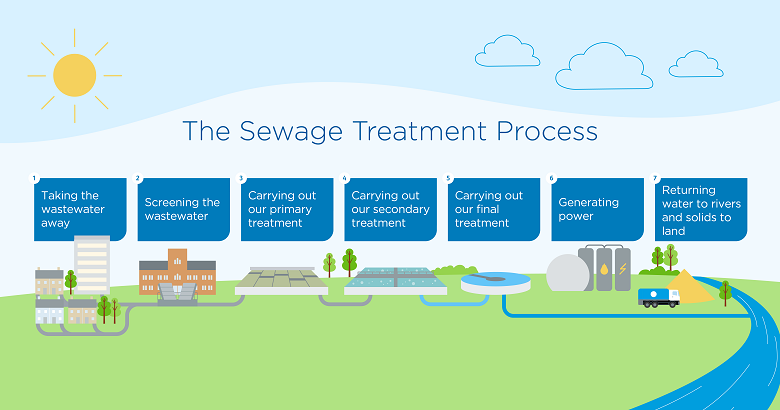Environmental Effect of Waste Water Treatment: What You Need to Know
Environmental Effect of Waste Water Treatment: What You Need to Know
Blog Article
Strategic Approaches to Boost Waste Water Treatment Efficiency and Lessen Ecological Influence
In the realm of waste water treatment, the mission for improved performance and minimized environmental impact is a perpetual difficulty that requires strategic services. As culture faces the critical to manage water resources sustainably, a nuanced method ends up being essential. The integration of advanced treatment technologies, energy-efficient processes, source recovery techniques, improved nutrient elimination techniques, and smart surveillance and control systems represents a diverse framework for resolving these pushing problems. What exists at the core of this complicated internet of approaches is the possible to reinvent the method we approach waste water treatment, not simply as a process of disposal, but as a valuable opportunity for development and environmental stewardship.
Advanced Therapy Technologies
Advanced membrane purification systems have actually changed advanced wastewater therapy procedures, substantially enhancing the removal of impurities. These innovative systems work by forcing water via a semi-permeable membrane, efficiently dividing pollutants from the water stream. The membrane layer's microscopic pores catch toxins such as bacteria, infections, and suspended solids, enabling just detoxified water to go through. This innovation has verified to be very efficient in removing a large range of impurities, including pharmaceuticals, heavy metals, and organic compounds, which are often challenging to get rid of with standard treatment techniques.
Moreover, membrane layer filtering systems provide numerous benefits over conventional therapy approaches. Additionally, these systems are very versatile and can be conveniently integrated right into existing treatment plants or used as standalone devices for decentralized applications.
Energy-Efficient Processes
The integration of energy-efficient processes in wastewater treatment systems is crucial for maximizing source application and decreasing functional costs. One vital method to improving power performance in wastewater treatment is the use of innovative aeration systems, such as fine bubble diffusers or surface aerators, which can improve oxygen transfer effectiveness and lower energy consumption.
Moreover, enhancing process control and automation via the usage of innovative sensing units and keeping an eye on systems can improve total power effectiveness by changing procedures in real-time based on real demand and problems. Implementing power audits and frequently keeping an eye on power efficiency indications are crucial techniques to recognize locations for improvement and track energy-saving initiatives properly. On the whole, the fostering of energy-efficient procedures in wastewater therapy not just profits the atmosphere however likewise adds to lasting expense savings and operational sustainability.
Resource Healing Methods
With an emphasis on optimizing resource application and sustainability in wastewater therapy systems, the execution of source recovery strategies arises as an essential facet in boosting operational efficiency. Source healing strategies in wastewater treatment entail the recognition and extraction of beneficial resources from the waste stream, consequently transforming what was when considered waste into a useful possession. By executing source healing techniques such as nutrient removal and recovery, power generation from organic issue, and the production of multiple-use water, wastewater treatment plants can decrease ecological impact while making the most of effectiveness.

Improved Nutrient Removal Methods
Executing sophisticated nutrient removal strategies is necessary for maximizing the performance of wastewater treatment systems. Enhanced nutrient elimination plays a crucial duty in lessening the ecological effect of cured effluent released into water bodies. Among the vital strategies utilized for enhanced nutrient elimination is the process of organic nutrient the original source elimination (BNR), which includes the removal of nitrogen and phosphorus via biological procedures. This can be attained with the use of specialized microbes that can convert nitrogen substances into inert nitrogen gas with denitrification, and collect phosphorus within their cells through a procedure called improved organic phosphorus removal (EBPR)

Along with BNR, advanced therapy approaches such as membrane bioreactors (MBRs) and created wetlands can also be used to enhance nutrient removal performance. MBRs make use of membranes to accomplish high-quality effluent requirements by properly removing nutrients and suspended solids. Constructed wetlands imitate all-natural marsh procedures to eliminate nutrients via plant uptake, microbial task, and sedimentation. By incorporating these sophisticated nutrient removal methods right into wastewater therapy sectors, districts and systems can properly decrease nutrient contamination and protect the environment.
Smart Surveillance and Control Equipment
Utilizing sophisticated modern technology, the combination of wise monitoring and control systems changes the operational efficiency of wastewater treatment centers. These systems integrate advanced sensors and information analytics to continuously keep track of essential parameters such as pH degrees, turbidity, dissolved oxygen, and flow prices in real-time. By collecting and analyzing this information, operators can gain valuable understandings into the efficiency of the treatment processes, making it possible for positive adjustments to maximize treatment effectiveness.
Smart monitoring and control systems additionally sustain remote monitoring capacities, allowing operators to access real-time data and control functions from off-site locations. This remote access improves functional flexibility and responsiveness, allowing speedy interventions in case of system breakdowns or fluctuations in influent high quality. Furthermore, the anticipating maintenance abilities of these systems aid avoid tools failures and lessen downtime, ultimately enhancing the total reliability of wastewater treatment procedures (Waste Water Treatment).
Conclusion
In final thought, critical approaches such as sophisticated treatment technologies, energy-efficient processes, source recuperation approaches, enhanced nutrient removal methods, and clever surveillance and control systems play an important function in improving wastewater therapy performance and reducing environmental effect. By carrying out these methods, wastewater therapy plants can official statement boost their total efficiency, lower power intake, recuperate useful resources, and guarantee compliance with environmental regulations. These methods are necessary for lasting and efficient wastewater monitoring methods.

In conclusion, calculated methods such as innovative treatment modern technologies, energy-efficient procedures, source healing methods, enhanced nutrient removal strategies, and smart surveillance and control systems play a vital role in improving wastewater therapy efficiency and reducing environmental influence.
Report this page